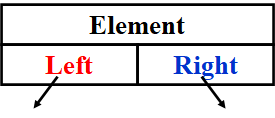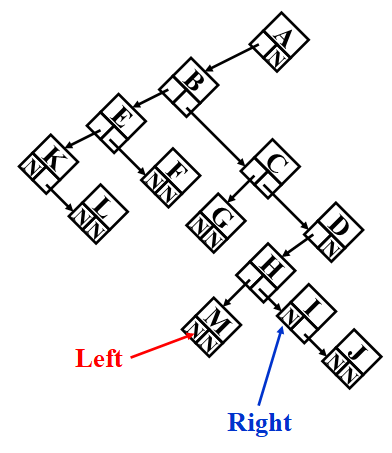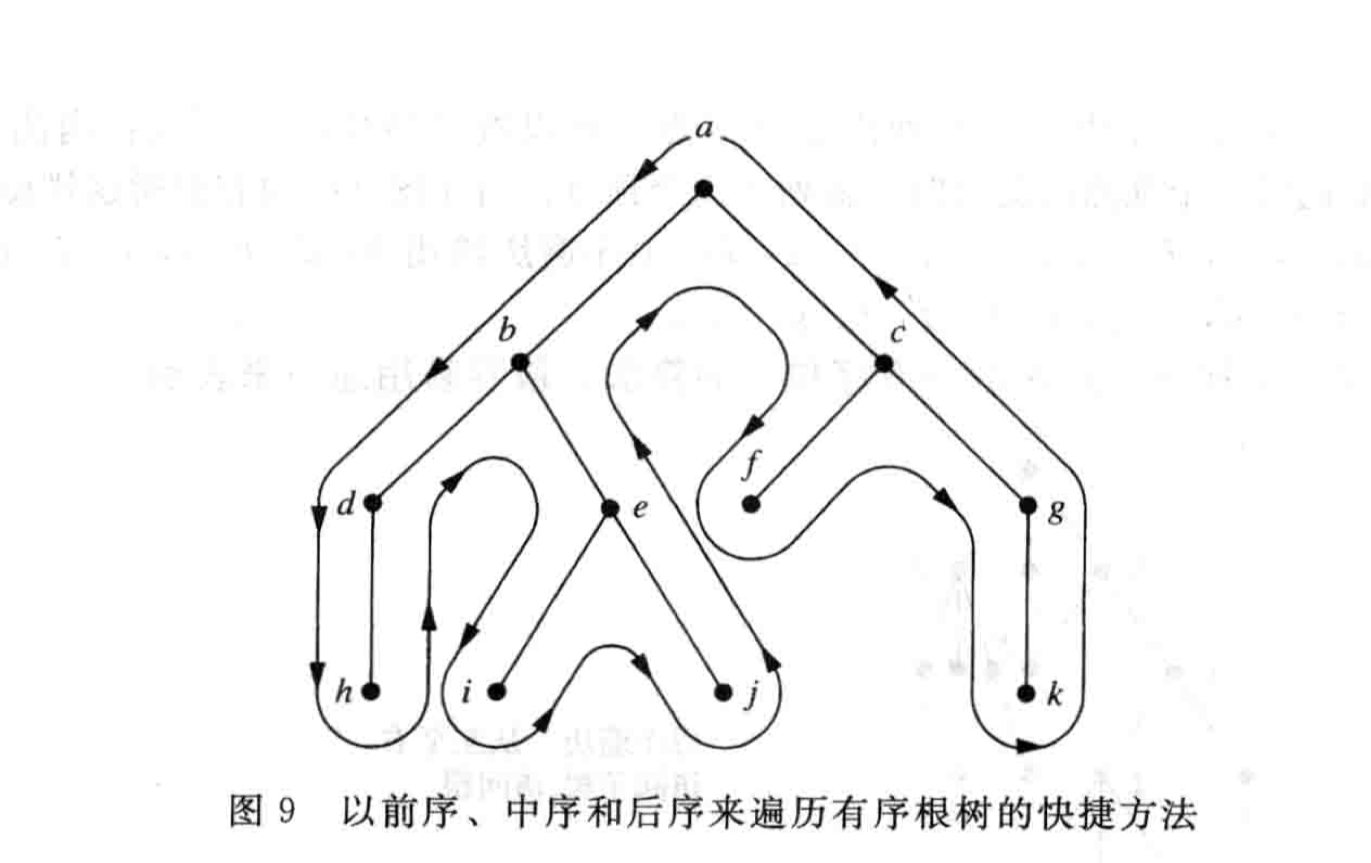相关定义
树叶(leaf):没有儿子的节点。
兄弟(sibling):有相同父亲的节点。到
路径长(length):边的条数。
的深度(depth):根到
的路径长。
的高度(height):从
到一片树叶的最长路径长。
树的实现
FirstChild-NextSibling Representation
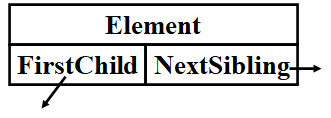

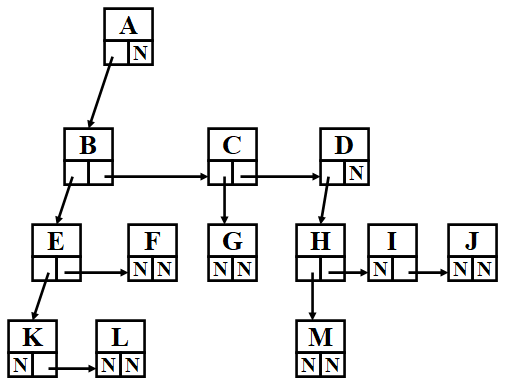
这种表示方法不唯一,因为没有规定children的顺序。
二叉树 | Binary Tree
树的遍历 | Tree Traversals
先、中、后序遍历
层次遍历
用到了队列数据结构。每次出队一个节点,就把它的所有孩子加入队列。伪码如下:
void levelorder ( tree_ptr tree ){ enqueue ( tree );while (queue is not empty) {visit ( T = dequeue ( ) );for (each child C of T )enqueue ( C );}}
具体实现(同时可以知道现在遍历到哪个层次)
void levelOrder(struct tree *BT){int level = 1;struct *queue[MEM], **front = queue, **rear = queue;struct tree * curNode = BT;//enqueueif(BT != NULL){*rear = BT;rear++;*rear = NULLrear++; //把NULL作为分隔标志,借此确定层次}while(front != rear){curNode = *front;front++; //dequeueif (curNode == NULL) { //遇到NULL分隔符,说明确实遍历了一个层次if (front == rear) break;level++;*rear = NULL; //rear++;continue;}if (curNode->left != NULL) {*rear = curNode->left;rear++;}if (curNode->right != NULL) {*rear = curNode->right;rear++;}}}
用栈实现前、中、后序遍历(None Recursive Way)
利用栈的FILO特性和三种遍历的特点。
#include <stdio.h>#include <stdlib.h>#define MAXN 100#define INF -9223372036854775808struct tree {int data;struct tree *left, *right;}*binTree;struct tree*createTree(int in[],int pre[],int n) {if (n == 0) return NULL;struct tree *root = (struct tree *) malloc(sizeof(struct tree));root->data = pre[0];int n1 = 0, n2 = 0, here = 0,lIn[MAXN] = {0}, rIn[MAXN] = {0}, lPre[MAXN] = {0}, rPre[MAXN] = {0};while (in[here] != pre[0]) here++;for (int i = 0; i < here; i++) lIn[n1++] = in[i];for (int i = here + 1; i < n; i++) rIn[n2++] = in[i];for (int i = 0; i < n1; i++) lPre[i] = pre[i + 1];for (int i = 0; i < n2; i++) rPre[i] = pre[n1 + i + 1];root->left = createTree(lIn, lPre, n1);root->right = createTree(rIn, rPre, n2);return root;}/*入栈一个节点就出栈并访问其值,遇到空时弹出当前栈顶节点并访问其右子树,重复之前操作*/void stackPreOrder(struct tree*root) {int stack1[MAXN] = {0}, s1Bottom = INF, *sp1 = &s1Bottom; //actually do not need stack1 nowstruct tree **stack2[MAXN], *s2Bottom = NULL, **sp2 = &s2Bottom;while (root != NULL || sp2 != &s2Bottom) {if (root) {*(++sp1) = root->data;*(++sp2) = root; //pushprintf("%d ", root->data);root = root->left;} else {root = *(sp2--);root = root->right;}}}/*一直访问左子树直至遇到空,弹出栈顶节点,访问其值,并访问其右子树*/void stackInOrder(struct tree*root) {int stack1[MAXN] = {0}, s1Bottom = INF, *sp1 = &s1Bottom; //actually do not need stack1 nowstruct tree **stack2[MAXN], *s2Bottom = NULL, **sp2 = &s2Bottom;while (root != NULL || sp2 != &s2Bottom) {if (root) {*(++sp2) = root;root = root->left;} else {root = *(sp2--);printf("%d ",root->data);root = root->right;}}}void stackPostOrder(struct tree*root) {int stack1[MAXN] = {0}, s1Bottom = INF, *sp1 = &s1Bottom;struct tree **stack2[MAXN], *s2Bottom = NULL, **sp2 = &s2Bottom;while (root != NULL || sp2 != &s2Bottom) {if (root) {*(++sp1) = root->data;*(++sp2) = root;root = root->right;} else {root = *(sp2--);root = root->left;}}while (sp1 != &s1Bottom)printf("%d ", *(sp1--));}int main() {int n, in[MAXN], pre[MAXN];scanf("%d", &n);for (int i = 0; i < n; i++) scanf("%d", &in[i]);for (int i = 0; i < n; i++) scanf("%d", &pre[i]);binTree = createTree(in, pre, n);printf("preorder:\n");stackPreOrder(binTree);printf("\ninorder:\n");stackInOrder(binTree);printf("\npostorder:\n");stackPostOrder(binTree);}
树的建立
根据中序和后(前)序建立树
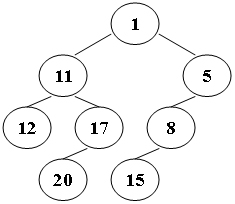
用这个树举个例子,inorder:12->11->20->17->1->15->8->5,postorder:12->20->17->15->8->5->1。
可以注意到postorder的特点是根节点总在最后一个被访问,据此可以把inorder分为左子树和右子树,进行完这个过程后,可以把postorder再分为左子树和右子树,至此,可以进行递归。如此操作直到左子树没有元素后到达递归出口。
如果后序改为前序,则根节点总在第一个被访问,其余相同。
struct tree* createTree(int inSeq[], int postSeq[], int items) {if (items == 0) {return NULL;} //没有元素,开始返回struct tree* root = (struct tree*)malloc(sizeof(struct tree));int lInSeq[MEM], rInSeq[MEM], lPostSeq[MEM], rPostSeq[MEM];root->key = postSeq[items - 1];//将inorder分为左子树和右子树int lItems = 0, rItems = 0;for (int i = 0; i < items; i++) {if (i <= lItems && inSeq[i] != postSeq[items - 1]) {lInSeq[lItems] = inSeq[i];lItems++;}if (i > lItems) {rInSeq[rItems] = inSeq[i];rItems++;}}//将postorder分为左子树和右子树for (int i = 0; i < lItems; i++) lPostSeq[i] = postSeq[i];for (int i = lItems; i < items - 1; i++) rPostSeq[i - lItems] = postSeq[i];root->left = createTree(lInSeq, lPostSeq, lItems);root->right = createTree(rInSeq, rPostSeq, rItems);return root;}
树的性质
一些树
Threaded Binary Trees
一个满二叉树,n个顶点,有n-1条边,n+1个NULL边,浪费很大。
这里的规则建立起了inorder的Threaded Binary Trees。
- Rule 1: If Tree->Left is
NULL, replace it with a pointer to the inorder predecessor(前辈) of Tree. - Rule 2: If Tree->Right is
NULL, replace it with a pointer to the inorder successor(后继者) of Tree. Rule 3: There must not be any loose threads. Therefore a threaded binary tree must have a head node of which the left child points to the first node.
typedef struct ThreadedTreeNode *PtrTo ThreadedNode;typedef struct PtrToThreadedNode ThreadedTree;typedef struct ThreadedTreeNode {int LeftThread; /* if it is TRUE, then Left */ThreadedTree Left; /* is a thread, not a child ptr. */ElementType Element;int RightThread; /* if it is TRUE, then Right */ThreadedTree Right; /* is a thread, not a child ptr. */}
语法树 | Syntax Tree
二叉搜索树 | Binary Search Tree
定义
每个节点都有一个值为整数的key,且互不相同。
- 对于一个顶点,其左子树的所有key小于顶点的key,右子树的key大于顶点的key。
- 左右子树也是二叉搜索树。
-
操作
Insert
先检查要插入的元素是否在树中,若不在,再执行插入。
伪码如下:SearchTree Insert( ElementType X, SearchTree T ) {if ( T == NULL ) { /* Create and return a one-node tree */T = malloc( sizeof( struct TreeNode ) );if ( T == NULL )FatalError( "Out of space!!!" );else {T->Element = X;T->Left = T->Right = NULL; }} /* End creating a one-node tree */else /* If there is a tree */if ( X < T->Element )T->Left = Insert( X, T->Left );elseif ( X > T->Element ) T->Right = Insert( X, T->Right );/* Else X is in the tree already; we'll do nothing */return T; /* Do not forget this line!! */}
Delete
删除叶节点:将其parent指向null。
- 删除度为1的节点:用它的孩子代替它。
- 删除度为2的节点:用其左子树中最大的元素或右子树中最小的元素代替它,再把这个元素从树中删除。这样做的目的是降低树的高度,尽量达到Complete Binary Tree。
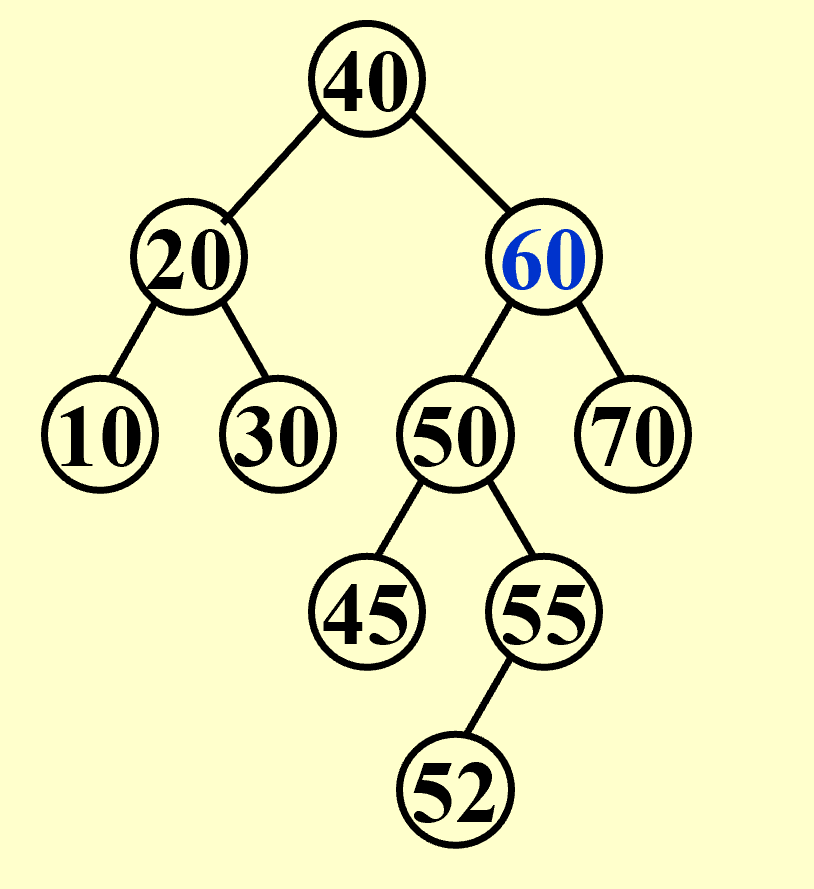

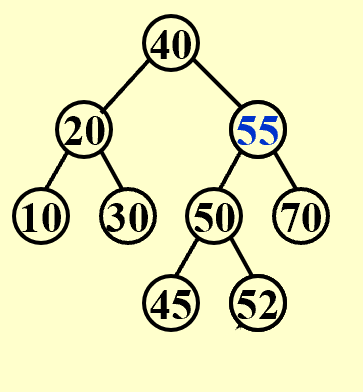
SearchTree Delete( ElementType X, SearchTree T ){ Position TmpCell;if ( T == NULL ) Error( "Element not found" );else if ( X < T->Element ) /* Go left */T->Left = Delete( X, T->Left );else if ( X > T->Element ) /* Go right */T->Right = Delete( X, T->Right );else /* Found element to be deleted */if ( T->Left && T->Right ) { /* Two children *//* Replace with smallest in right subtree */TmpCell = FindMin( T->Right );T->Element = TmpCell->Element;T->Right = Delete( T->Element, T->Right ); } /* End if */else { /* One or zero child */TmpCell = T;if ( T->Left == NULL ) /* Also handles 0 child */T = T->Right;else if ( T->Right == NULL ) T = T->Left;free( TmpCell ); } /* End else 1 or 0 child */return T;}
Implementation of BST-ADT
#include <stdio.h>#include <stdlib.h>#include <time.h>#define MEM 100struct tree{int data;struct tree*left,*right;}*BST;int arr[MEM],n;struct tree*find(int X,struct tree*root) {if (root == NULL) return NULL;if (X < root->data) return find(X, root->left);else if (X > root->data) return find(X, root->right);else return root;}struct tree*findMin(struct tree*root){if(!root) return NULL;else{if(root->left==NULL) return root;else return findMin(root->left);}}struct tree*findMax(struct tree*root){if(!root) return NULL;else{if(root->right==NULL) return root;else return findMin(root->right);}}struct tree*insert(int X,struct tree*root) {if (root==NULL) {root=(struct tree*) malloc(sizeof (struct tree));root->data=X;root->left=root->right=NULL;}else{if(root->data>X) root->left=insert(X,root->left);else if(root->data<X) root->right=insert(X,root->right);else ; //do nothing when X is already in tree}return root;}struct tree*delete(int X,struct tree*root){struct tree* tmp;if(root==NULL) {printf("No this element");exit(0);}else if(X< root->data) root->left= delete(X,root->left);else if(X> root->data) root->right= delete(X,root->right);else{if(root->left&&root->right){ //has two childrentmp= findMax(root->left); //or findMin(root->right)root->data=tmp->data; //rewrite instead of swaproot->left= delete(root->data,root->left); //delete tmp}else { //no child or onetmp=root;if(root->left==NULL) root=root->right;else if(root->right==NULL) root=root->left;free(tmp);}}return root;}void inOrder(struct tree *root){if(root){inOrder(root->left);printf("%d ",root->data);inOrder(root->right);}}int main() {scanf("%d", &n);for (int i = 0; i < n; i++) {scanf("%d", &arr[i]);BST= insert(arr[i],BST);}inOrder(BST);printf("\n");srand(time(0));BST=delete(arr[rand()%n],BST);inOrder(BST);return 0;}
结合一定条件建立一个完全二叉搜索树
给定一个整数序列,建立完全二叉搜索树(是唯一的)。
- 将序列按升序排列,也即给出了中序序列,便于后续分割。
- 找到根节点(可以由完全二叉树性质推得),将树分为左右子树,对左右子树做相同操作。
这里排序我结合了一下后面堆 | Heap的知识,用了小顶堆排序。这里可以看到用数组存树是很方便的。
#pragma warning(disable:4996)#include <stdio.h>#include <math.h>#include <stdlib.h>#define MEM 10000#define MIN -1int n, arr[MEM], heapSize;int sortedArr[MEM], CBT[MEM];int leftSubElements(int nodes) {int height = (int)(log(nodes + 1) / log(2)); //get heightint leaves = nodes - (int)pow(2, height) + 1; //number of leaf nodesint half = pow(2, height-1); //half nmber of leaf nodesint leftLeaves = (leaves < half) ? leaves : half;return (int)pow(2, height - 1) - 1 + leftLeaves;}void percolateDown(int pos) {int X = arr[pos], i, child;for (i = pos; i * 2 <= heapSize; i = child) {child = i * 2;if (child != heapSize && arr[child + 1] < arr[child]) child++;if (arr[child] < X) arr[i] = arr[child];else break;}arr[i] = X;}void createMinHeap() {for (int i = heapSize / 2; i >= 1; i--) {percolateDown(i);}}void delete() {if (heapSize == 0) return;int min = arr[1];int last = arr[heapSize--];arr[1] = last;percolateDown(1);}void minHeapSort() {for (int i = 1; heapSize != 0; i++) {sortedArr[i - 1] = arr[1];delete();}}void createTree(int left, int right, int root) {int nodes = right - left + 1;if (nodes == 0) return;int leftNodes = leftSubElements(nodes);CBT[root] = sortedArr[left + leftNodes];createTree(left, left + leftNodes - 1, 2 * root + 1);createTree(left + leftNodes + 1, right, 2 * root + 1 + 1);}int main() {scanf("%d", &n);heapSize = n;arr[0] = MIN;for (int i = 0; i < n; i++) scanf("%d", &arr[i + 1]);createMinHeap();minHeapSort();createTree(0, n - 1, 0);for (int i = 0; i < n; i++) {if (i == 0) printf("%d", CBT[i]);else printf(" %d", CBT[i]);}return 0;}
